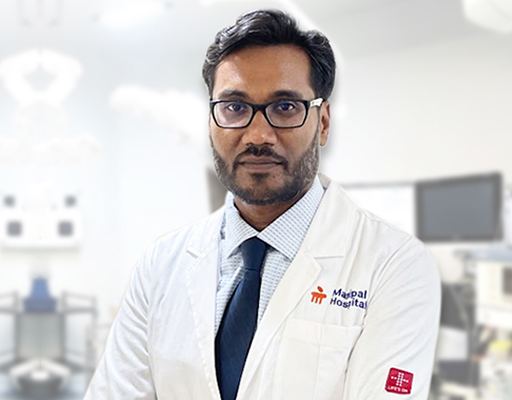-

According to the latest statistics, around 25 percent of males and 2 percent of females develop inguinal hernia (considered to be the most common of all hernias) across the globe. There are two types of inguinal hernia, - direct inguinal hernia and indirect inguinal hernia. Indirect inguinal hernia is the most common in both men and women.
In the United Kingdom, around 100,000 inguinal hernias are repaired every year; while in the United States, it’s around 750,000. In India, the estimated annual incidence of inguinal hernia repair is 1,957, 850.
Hernia in general, forms in a person when there is a hole or weakness in the peritoneum (muscular wall). Peritoneum is an important part of the human body which plays a pivotal role. It keeps the organs in the abdominal region in place. Now, when the organs or tissues are nudged aside, they form a bulge, resulting in the organs or tissues getting herniated. Hernias mostly occur in the abdomen or upper thighs or groin region. Although they are not life-threatening, surgery to rectify the hernia is recommended so as to prevent dangerous complications from germinating later.
That said, hernia is a painful condition, especially when an internal organ bulges out from a weakened area in the muscles around it. It needs immediate medical attention. This is where; the best surgeon in Bangalore at M H Surgery will help to rectify and fix the problem.
RISKS OF HERNIAS
Generally in many people’s cases, a hernia may be present right from birth. It is termed as a congenital disorder like congenital diaphragmatic Hernia; OR could develop when young as a child with a weak abdominal wall.
In other cases, the risk of hernia increases due to
- Increase in age, that is, as people grow older. Herein, the risk of hernia is more prevalent in men than women.
- Complications resulting from abdominal surgery. This will lead to incisional hernia. Activities like lifting heavy items, physical exertion, and smoking; and medical issues like straining on the toilet or to urinate; persistent cough; cystic fibrosis; obesity; abdominal fluid; enlarged prostrate; un-descended testicles; and poor nutrition, are primarily responsible for causing abdominal wall issues.
RISK FACTORS IN VARIOUS HERNIAS
INCISIONAL HERNIA
It occurs mostly in women. The hernia develops when the women hernia patient involves herself in strenuous activities; or gains excess weight; or becomes pregnant; after three to six months of the hernia surgery. All of these put a lot of pressure on the healing tissue.
UMBILICAL HERNIA
It occurs in babies who are born prematurely or born with a low birth weight; adults who have excess weight; and women who are involved in multiple pregnancies.
HIATAL HERNIA
It occurs in individuals who are aged over fifty years; and also people who suffer from excess weight.
ALL ABOUT INGUINAL HERNIA
Inguinal hernia is also called as Groin Hernia. The word ‘Inguinal’ means ‘In the groin’.
Termed as the most common of all hernias, an inguinal hernia occurs in a passageway of the groin called inguinal canal (runs down either side of the pelvis into the sex organs).
This can occur due to
- Tissue from one body cavity forcing its way through an opening in the muscle wall into another body cavity; or
- Belly fat or a loop of intestines, bulging through an opening in the lower abdominal wall, that is, the wall that separates the abdomen from the groin.
IN WHOM IT OCCURS?
It occurs in older adults, especially males and those with hereditary issues; people who tend to smoke a lot; and people who suffer from chronic constipation. Additionally, it also happens in women who suffer from pregnancy issues; and babies with low birth weight, or born prematurely.
TYPES OF INGUINAL HERNIA
There are two types of inguinal hernia. They include:
DIRECT INGUINAL HERNIA: This type of inguinal hernia juts or penetrates through the inguinal canal’s wall directly. The cause of this hernia is a combination of weakened abdominal muscles and chronic pressure on the muscle wall, in adults.
INDIRECT INGUINAL HERNIA: This type of inguinal hernia enters the inguinal canal through the top. It results from a birth defect in a person. There are some fetuses where the opening to the inguinal canal does not close normally all the way during the development of the uterus.
PATHOPHYSIOLOGY OF INGUINAL HERNIA
The pathopysiology of inguinal hernia lies in weakness or opening in the lower abdominal wall. This allows the abdominal tissue to push through the weakened abdominal wall.
The cause of this issue is multiple factors like
- Weakening of muscles as one grows old. The muscles will give out faster as one gets older due to changes in the cellular growth process brought on by free radicals.
- Inflammatory muscle disease like Myositis caused by a bacteria or virus or parasite. Due to this, the muscle fibers accumulate multiple proteins thereby creating weakness and pain to the muscles.
- Muscle deficiency with glycogen storage. This causes the muscle to weaken and injure easily. It is a disorder that is generally genetically inherited.
Aside from this, the inguinal hernia also indicates multiple factors like
- Opening or weak spot already present at birth of the person; OR present due to earlier abdominal surgery.
- Stress or increased use of the abdominal muscles.
- Muscular damage. This involves multiple problems in the cells of the muscle leading to damages.
- Congenital disorder in the strength of the connective tissue called as collagen.
- Chronic coughing or sneezing; or straining to poop or pee.
- Multiple pregnancies in the case of women, and carrying small children.
- Job tasks that necessitate continual standing for hours at a time.
- Intrabdominal pressure resulting from chronic obesity.
- Frequent bouts of strenuous exercise or manual labor.
- Normal age-related tissue degeneration.
Another significance of Inguinal hernia is that the inguinal hernia could be large enough to block arterial blood flow to the area of the hernia sac. This aspect is called ass strangulation, a life-threatening issue that should be treated surgically right away.
SYMPTOMS OF INGUINAL HERNIA
Not all types of inguinal hernias have symptoms. There are times when the symptoms come and then disappear like in the case of children when they sleep. Likewise, on other occasions the hernia may get in and out of the opening; or may be felt during certain kind of activities; in children it can be detected from a lump on their groin that will appear bigger when they cry. On some other occasions, it may not be felt even when the specific area of the body is touched. That is because the inguinal hernia may be tucked behind muscle fibers.
HOW IT CAN BE DETECTED?
It can be detected by a bulge on either side of the pelvic bone that’s caused by abdominal tissue pushing through an opening in the lower abdominal wall. The opening in the lower abdominal wall can be congenital, that is, present at birth; or due to normal, age-related degeneration of the muscle.
Aside from this, it can also be detected by
- Pressure or heaviness felt on the groin.
- Pain felt in the groin, especially when one strains or lifts or coughs or bends over.
- Burning or tingling sensation radiating through the pelvis or down the leg.
HOW TO PREVENT IT FROM OCCURING?
Inguinal hernia can be prevented by reducing the risks of the causes or symptoms of inguinal hernia.
Like
- Avoiding the lifting of heavy objects. Or resisting the urge to lift heavy objects.
- Avoiding putting on excess weight and instead maintaining a healthy and proper weight.
- Stopping the habit of smoking or resisting the urge to smoke.
- Eating lots of fiber-rich food.
Aside from this, it is also important to take proper care after surgery to repair a previous inguinal hernia. ELSE, there lies a high chance of contracting a hernia again in the future.
OPEN INGUINAL HERNIA REPAIR
In an open inguinal hernia repair surgery, the surgeon will create an incision in the abdomen. Then pushes the hernia back into the abdomen; and later repair the hole that allowed the hernia to push through the abdominal wall.
An open inguinal hernia repair surgery process by the surgeon goes as follows:
- Administration of general anesthesia in case of big size hernia; or local anesthesia in case of small size hernia. In the case of big size hernia, patient will be kept asleep during the surgery; this will help to prevent experiencing of any pain that can occur during the surgery. ON the other hand, in the case of small size hernia, the patient will be awake during the surgery procedure, but at the same time will receive medications to numb the pain, if any felt during the surgery; and stay relaxed.
- Incision is made through the affected spot to create a hole. This will help to locate the hernia and separate it from the surrounding tissues.
- Herniated tissue is pushed back into place in the abdomen.
- Stitches are done to close-up the tear; or strengthen the weak abdominal muscles. In the case of weak abdominal tissues, surgeon may attach mesh to strengthen it. This will help to reduce the risk of another hernia happening again.
RISKS OF OPEN INGUINAL HERNIA REPAIR
The risks of open inguinal hernia repair include allergic reactions to anesthesia and other medications; bleeding; breathing issues; and infection. Aside from these, other risks include prolonged pain at the site of the hernia; damage to blood vessels (in the case of men, their testicles can get harmed where connecting blood vessels are damaged); damage to nerves or nearby organs; or chances of hernia coming back.
RECOVERY FROM OPEN INGUINAL HERNIA REPAIR
Generally, recovery from inguinal hernia depends on the type of procedure undertaken; and the size and severity of the hernia of the affected person. Overall, the recovery from surgery varies from person to person.
In most people’s cases, it could take up to six weeks for a complete recovery.
After recovery, the patient can feel a certain amount of discomfort or pain for some days after the surgery. Also, the patient can feel numbness or pain around the groin area, if the surgeon had damaged a nerve during the open inguinal hernia repair. Aside from these, the patient should also watch out for symptoms like drainage, heat, redness, swelling, or worsening pain around the area of incision.
Overall, one in ten people will continue to experience persistent pain after open inguinal hernia repair. To alleviate them, the surgeon may recommend pain relief drugs or medication. This will help to block the affected nerve. There are times, if all of these fail, further surgery may be required.
To stay safe, the patient must talk to the surgeon about what needs to be done to manage the pain. Additionally, the patient must also look for out any unwanted changes that might indicate that an infection is occurring.
Coming to getting back to work after recovery process, it depends on each person’s case. In case, the person’s job does not involve tasks like lifting and such likes, then he/she can return after one to two weeks. The surgeon will give necessary precautionary tips like avoiding heavy lifting and physical activities for a few weeks.
MANAGEMENT OF INGUINAL HERNIA
The management of inguinal hernia varies from person to person.
Urgent surgical intervention in the form of open inguinal hernia repair or laparoscopic repair will be required in the following cases.
- People who experience strangulation. Every year, about 2 percent chances of risks of strangulation (like pain out of proportion to clinical features; or deranged biochemical results) with an inguinal hernia.
- People who suffer from a symptomatic inguinal hernia (that is, from significant mass or feeling of discomfort).
Around a third of patients with an inguinal hernia never experience any kind of symptoms. However, they need to keep in touch with their surgeon regarding chances of symptoms of potential strangulation, and future surgical intervention.
Surgical intervention is undertaken only after evaluation of the patient’s health, fitness, and surgical preference.
Likewise, a laparoscopic surgery is recommended for those with bilateral or recurrent inguinal hernias; and in certain cases, those patients with a primary unilateral hernia, especially those with a high risk of chronic pain; or females who suffer from an increased risk of the presence of femoral hernia.
CONCLUSION
Consult the best surgeon in Bangalore at M H Surgery for inguinal hernia on what needs to be done to rectify it.
Based on the severity of your inguinal hernia, the best surgeon in Bangalore at M H Surgery could recommend two types of hernia surgeries – open inguinal hernia repair or laparoscopic.
M H Surgery has some of the best surgeons in Bangalore and India who possess high expertise and skills in treating hernias
Book an appointment today with the Dr. Manjunath Haridas to know more about your inguinal hernia and what can be done to get rid of it.

Author: DR. MANJUNATH HARIDAS (MD FACS FICS)
Dr. Manjunath Haridas is one of the leading surgeons for Gastrointestinal Sciences in Whitefield, Bangalore. His area of expertise includes Gastrointestinal Surgery - Colon Rectum, Foregut Advanced Laparoscopic Surgery, and Minimally invasive surgery. He is Honored by the American Board of Certification, fellow Of the American College of Surgeons, SAGES membership and more.

